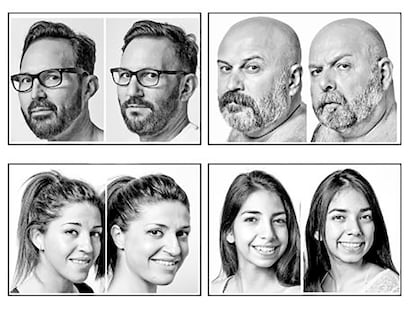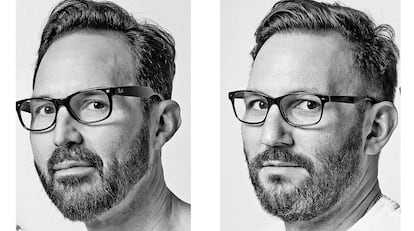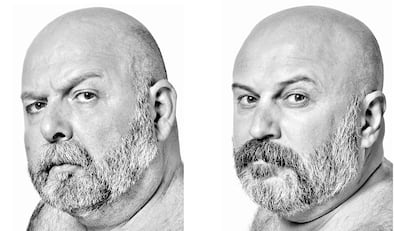Similar faces share similar DNA
A new study reveals that lookalikes with no familial ties have similar genetic makeup. This discovery may have important implications within the forensic sciences

Our faces, at first glance, are what differentiate us from one another. Sometimes, though, people can look virtually identical, even if they don’t have any shared blood. Spanish researchers have discovered that these lookalikes actually have more than superficial features in common – in fact, they may even have genetic similarities.
“What unites lookalikes the most is their DNA sequence,” says lead scientist Manel Esteller, who has published his group’s findings in the scientific journal Cell Reports. “Genomics groups them together.”
The study reveals that genetic similarities may not only result in facial resemblances, but also in similar habits or behaviors. The results will likely have long-term implications within the forensic sciences.
The researchers identified pairs of virtual doppelgangers by looking through the works of photographer François Brunelle, a Canadian artist who has spent more than 20 years taking images of lookalikes around the world. The researchers subsequently passed them through facial recognition programs so that algorithms could verify the similarities. The 32 pairs that were eventually recruited ended up having confirmed resemblances in three recognition systems, with scores similar to those obtained by identical twins. Biological samples were then taken from the 64 participants, who were then subjected to exhaustive questionnaires about their habits and lifestyles.
“In 2005, we discovered that identical twins, called monozygotes, had the same DNA. I then decided to look at people who looked alike, but weren’t twins. I wanted to know how much [of that resemblance] came from nature or from the environment that surrounded them,” explains Esteller.

The researchers looked at the genome, but also at the epigenome, which can attach to DNA and cause functional changes, like a kind of switch that – conditioned by environments or habits – turns off or turns on the activity of genes. The scientists also analyzed the microbiome of the participants, or the ecosystem of microorganisms that populate a human being.
“We found that what binds [each pair of virtual doubles] the most is their DNA sequence, their genomes. By chance, similar genomes end up being produced [in unrelated people]. That’s because there are so many people in the world that DNA is repeated,” explains Esteller. They are not identical, but they share similarities, the researcher specifies: “Similarities in their genomes explain the similarity of these pairs; however, the different composition of their epigenomes helps to differentiate them.”
The research offers clues about the genetic environment associated with facial appearance. For example, genetic variations shared by the doubles were associated with physical characteristics, such as lip or eye color, hip circumference, height, body mass index or hair. But the research suggests that these molecular similarities found influence beyond the construction of the face. The study points out a facial correlation with certain physical attributes, habits and behaviors:
“We saw that there is greater genetic determination in whether [the participants] are left-handed or right-handed, or prone to addictions like smoking.”
Through the lifestyle questionnaires and biometric parameters, the article points out that, in matters such as height, weight, level of education or smoking habits, those who are superficially similar have more in common than those who do not look alike.
The researchers admit that there are some limitations in their study, such as the small number of participants, the fact that the majority were European, or that the photos were in black-and-white, resulting in a lack of definition of skin tone and features. But Esteller is confident that, despite all of this, the study opens a new door in the scientific community and points to two possible derivatives:
“It may have forensic implications, because from an unknown genome, you can start to construct a face. And, on the other hand, by looking at a face, we can also begin to deduce the genome of the person. For example, if they have a certain kind of face, they may be more or less at risk of cardiovascular disease”,

Ángel Carracedo, a geneticist at the Institute of Forensic Sciences of the University of Santiago de Compostela – who did not participate in the study – notes that, while the results are “interesting,” they do not currently have direct application in the forensic field. It is, for now, an “exploratory” work…
but the study “broadens perspectives” in the forensic field, which uses some biomarkers, he says, such as the “biological witnesses” in police investigations.
“At the moment, the physical characteristics that can be determined with a good level of prediction for forensic purposes are pigmentation (especially eye and skin color), hair type and little else… new genes are very important to explore other facial and physical characteristics.”
Carracedo – who leads a project to design techniques that determine the physical characteristics, biographical origins and ages of people based on their DNA – agrees, however, that all of this must continue to be studied, replicated and validated, while meeting the highest forensic standards.
Tu suscripción se está usando en otro dispositivo
¿Quieres añadir otro usuario a tu suscripción?
Si continúas leyendo en este dispositivo, no se podrá leer en el otro.
FlechaTu suscripción se está usando en otro dispositivo y solo puedes acceder a EL PAÍS desde un dispositivo a la vez.
Si quieres compartir tu cuenta, cambia tu suscripción a la modalidad Premium, así podrás añadir otro usuario. Cada uno accederá con su propia cuenta de email, lo que os permitirá personalizar vuestra experiencia en EL PAÍS.
¿Tienes una suscripción de empresa? Accede aquí para contratar más cuentas.
En el caso de no saber quién está usando tu cuenta, te recomendamos cambiar tu contraseña aquí.
Si decides continuar compartiendo tu cuenta, este mensaje se mostrará en tu dispositivo y en el de la otra persona que está usando tu cuenta de forma indefinida, afectando a tu experiencia de lectura. Puedes consultar aquí los términos y condiciones de la suscripción digital.











































